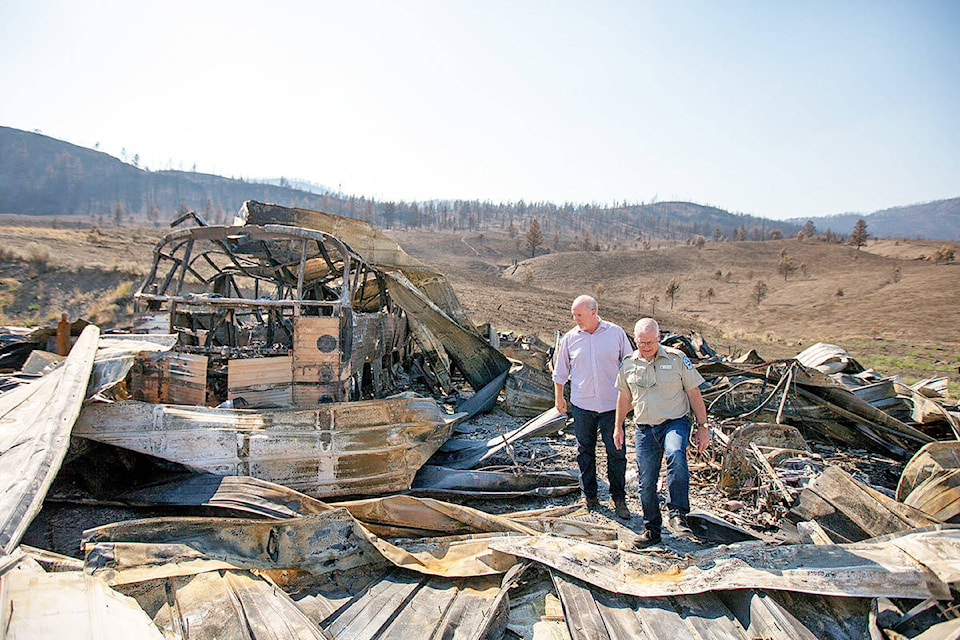Sobering is how B.C.’s Minister of Forests, Lands and Natural Resource Operations and Rural Development described the summer’s wildfires.
“There were so many areas that were burned and when I flew over some of the fires this summer I could see such a charred landscape,” Doug Donaldson told the Tribune this week.
“But I also know how resilient and diverse ecosystems are and there were areas that had not been totally consumed and animals and plants will regenerate from those areas as well.”
Donaldson said an estimated 53 million cubic metres of timber was impacted by wildfires in the Cariboo-Chilcotin and Thompson-Nicola regions, an amount he noted is equivalent to about one year of the Interior’s Annual Allowable Cut.
“We have our ministry staff on the ground now that the evacuation orders are lifted and some of the smoke has cleared,” the minister said. “We are finding there has been a real mix of what has happened on the land. It doesn’t necessarily mean 53 million cubic metres has been consumed totally by the flames.”
Some of the wood is salvageable, he noted
“There are areas that the fire really scorched the earth but there are other areas where the timber will be harvestable.”
Efforts are being made to expedite the cutting permits that fall within existing forestry licenses because it’s known the longer the impacted trees stand the less merchantable they will become, the minister said.
The ministry is issuing salvage licenses, but because they are new licenses they do take more time, and the third focus is making plans for reforestation which will be essential for the long term.
Earlier this month the City of Williams Lake and Cariboo Regional District announced they have applied for strategic wildfire prevention funding from the Union of BC Municipalities (UBCM) to implement a community wildfire prevention plan.
Donaldson said he met with Mayor Walt Cobb and CRD Chair Al Richmond during one of his visits to Williams Lake since he became minister and will have an opportunity to meet with them and other government representatives during the UBCM conference next week to talk more about the plan.
The government has organized its response to the wildfires in four focus areas based on the best practices learned from the Fort McMurray fires in 2016 and include communities, economy, environment and infrastructure reconstruction.
Under environment, the ministry has already begun work to rehabilitate sites that were disturbed by firefighting efforts, Donaldson said.
“For instance, there were a lot of fire guards created and we are already on to the re-seeding of those sites as well as looking at areas that are going to be high priority as far as erosion control goes,” Donaldson explained. “When you don’t have any vegetation left and if you get a big freshet in the spring the water comes and goes quickly.”
The ministry plans to do a comprehensive review of the province’s wildfire response that will begin this fall to determine what worked really well and what can be improved with fuel management around communities, Donaldson said.
Referring to the Filman Firestorm 2003 Provincial Review that was commissioned by the B.C. government after the Kelowna fires, the minister said there were major recommendations in the report to make the interface zones safer.
“A total of 685,000 hectares was identified as high risk and less than 10 per cent of that was treated under the B.C. Liberals,” Donaldson said. “We are going to determine in the review if that had any impact on what happened this summer around the interface zones and also we will be looking to learn about what we can do going into the future.”
A total of $140 million has been set aside in the latest budget update for the next three years, specifically for risk reduction and reforestation, he added.
“We will be looking to the federal government for some support. Last week I had senior staff in Ottawa making representation to get some support there as we will be looking for some federal funds to match what we’ve allocated in our updated budget,” Donaldson said, adding he is confident there will be people on the ground doing work in the forests around communities to help alleviate risk.
Now that the provincial state of emergency was removed on Friday, Sept. 15 because of the weather and the containment of the fires, recovery efforts are being co-ordinated through the Ministry of Forests.
